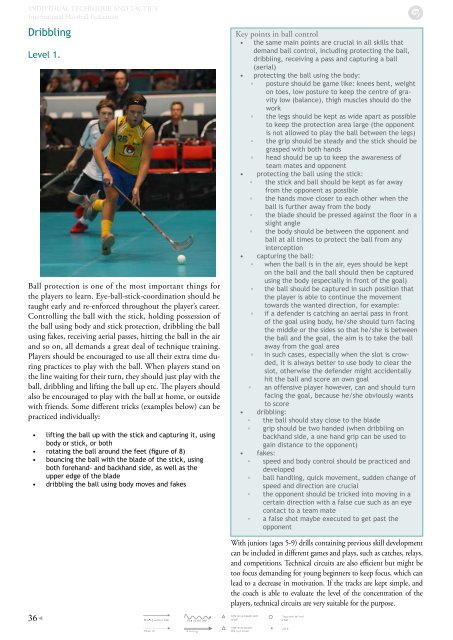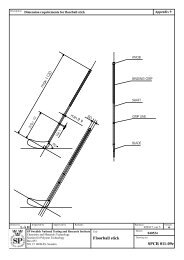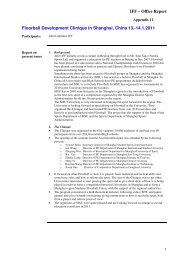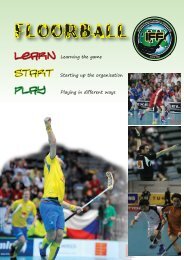INDIVIDUAL TECHNIQUE AND TACTICS - Wellington Floorball
INDIVIDUAL TECHNIQUE AND TACTICS - Wellington Floorball
INDIVIDUAL TECHNIQUE AND TACTICS - Wellington Floorball
- No tags were found...
You also want an ePaper? Increase the reach of your titles
YUMPU automatically turns print PDFs into web optimized ePapers that Google loves.
<strong>INDIVIDUAL</strong> <strong>TECHNIQUE</strong> <strong>AND</strong> <strong>TACTICS</strong>International <strong>Floorball</strong> FederationDribblingLevel 1.Ball protection is one of the most important things forthe players to learn. Eye-ball-stick-coordination should betaught early and re-enforced throughout the player’s career.Controlling the ball with the stick, holding possession ofthe ball using body and stick protection, dribbling the ballusing fakes, receiving aerial passes, hitting the ball in the airand so on, all demands a great deal of technique training.Players should be encouraged to use all their extra time duringpractices to play with the ball. When players stand onthe line waiting for their turn, they should just play with theball, dribbling and lifting the ball up etc. The players shouldalso be encouraged to play with the ball at home, or outsidewith friends. Some different tricks (examples below) can bepracticed individually:••••lifting the ball up with the stick and capturing it, usingbody or stick, or bothrotating the ball around the feet (figure of 8)bouncing the ball with the blade of the stick, usingboth forehand- and backhand side, as well as theupper edge of the bladedribbling the ball using body moves and fakesKey points in ball control• the same main points are crucial in all skills thatdemand ball control, including protecting the ball,dribbling, receiving a pass and capturing a ball(aerial)• protecting the ball using the body:◦ posture should be game like: knees bent, weighton toes, low posture to keep the centre of gravitylow (balance), thigh muscles should do thework◦ the legs should be kept as wide apart as possibleto keep the protection area large (the opponentis not allowed to play the ball between the legs)◦ the grip should be steady and the stick should begrasped with both hands◦ head should be up to keep the awareness ofteam mates and opponent• protecting the ball using the stick:◦ the stick and ball should be kept as far awayfrom the opponent as possible◦ the hands move closer to each other when theball is further away from the body◦ the blade should be pressed against the floor in aslight angle◦ the body should be between the opponent andball at all times to protect the ball from anyinterception• capturing the ball:◦ when the ball is in the air, eyes should be kepton the ball and the ball should then be capturedusing the body (especially in front of the goal)◦ the ball should be captured in such position thatthe player is able to continue the movementtowards the wanted direction, for example:◦ if a defender is catching an aerial pass in frontof the goal using body, he/she should turn facingthe middle or the sides so that he/she is betweenthe ball and the goal, the aim is to take the ballaway from the goal area◦ in such cases, especially when the slot is crowded,it is always better to use body to clear theslot, otherwise the defender might accidentallyhit the ball and score an own goal◦ an offensive player however, can and should turnfacing the goal, because he/she obviously wantsto score• dribbling:◦ the ball should stay close to the blade◦ grip should be two handed (when dribbling onbackhand side, a one hand grip can be used togain distance to the opponent)• fakes:◦ speed and body control should be practiced anddeveloped◦ ball handling, quick movement, sudden change ofspeed and direction are crucial◦ the opponent should be tricked into moving in acertain direction with a false cue such as an eyecontact to a team mate◦ a false shot maybe executed to get past theopponentWith juniors (ages 5-9) drills containing previous skill developmentcan be included in different games and plays, such as catches, relays,and competitions. Technical circuits are also efficient but might betoo focus demanding for young beginners to keep focus, which canlead to a decrease in motivation. If the tracks are kept simple, andthe coach is able to evaluate the level of the concentration of theplayers, technical circuits are very suitable for the purpose.36◄Movi vng without ballMovi vng with ballOffef nsive player witha ballOpponent withouta ballPassingShootingOffef nsive playerWithout a ballCone








